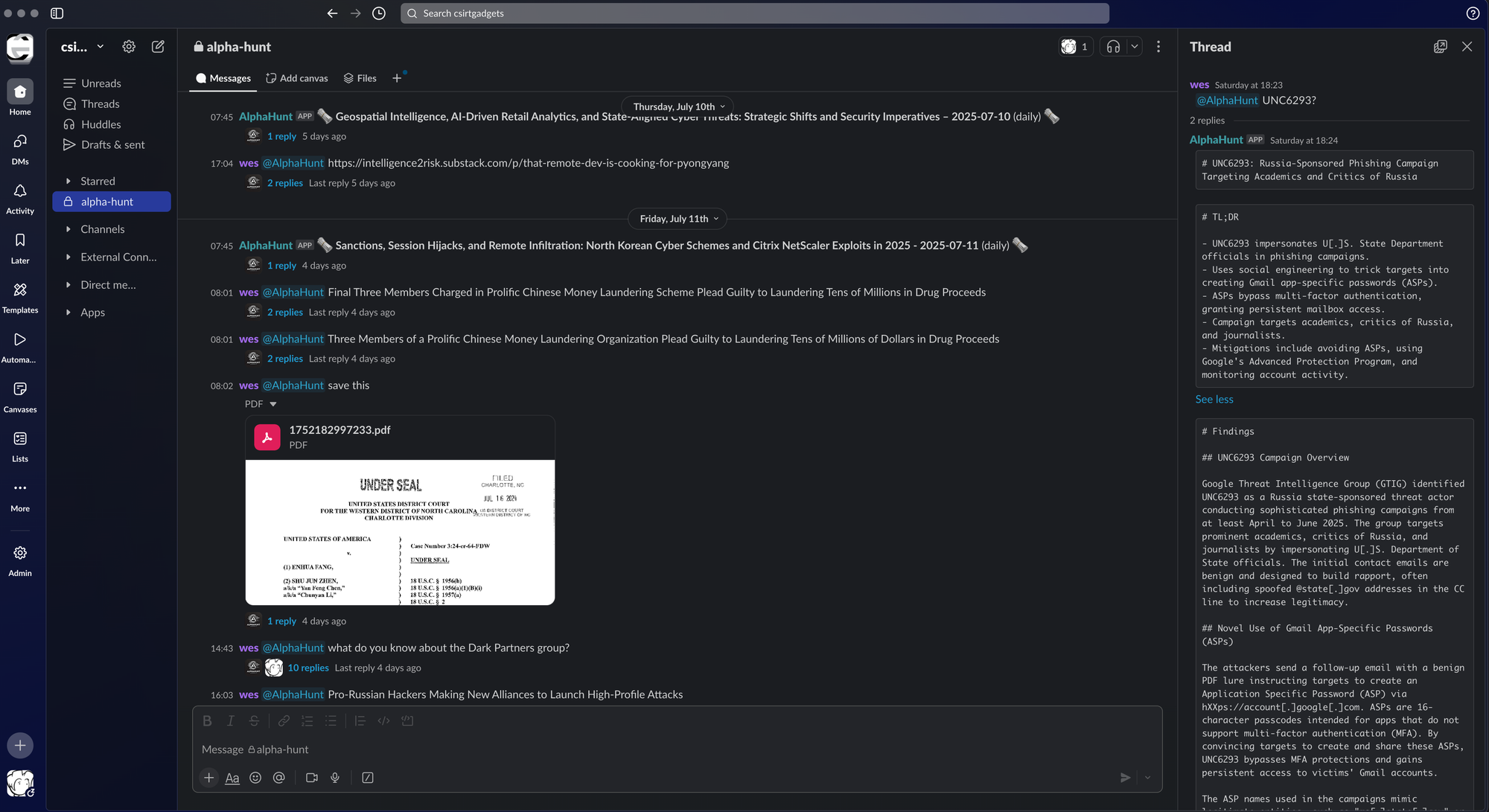By Dec 31, 2025, will a reputable primary source (Oracle, CISA, Mandiant/MSTIC, affected org’s SEC 8-K/IR blog) confirm at least one breach where CVE-2025-61882 was the initial access vector?
Oracle EBS zero-day (CVE-2025-61882): OOB patch, KEV-listed, exec extortion emails flying. We’re at 76% that a primary source names it as initial access by 12/31. Raise or fade? 🧨🧭

Early Look: AlphaHunt Forecasting
We’re giving our subscribers a look at something new: AlphaHunt’s early-stage, next-generation forecasting technology.
Most intel tools tell you what already happened. Forecasting asks a harder, more valuable question: what’s likely to happen next, and how should we prepare? We’re experimenting with structured probability models that connect threat intelligence to incident response. Think of it as a way to quantify uncertainty before the attacker makes their next move.
Why it matters for security teams
-
Move left of boom – Instead of reacting to the breach or extortion email, teams get an evidence-based probability of escalation. That helps decide whether to harden defenses now or stage response playbooks in advance.
-
Translate noise into action – Forecasts take vague “chatter” or scattered reporting and turn it into calibrated odds with defined resolution criteria. That means you can brief leadership with confidence, not hand-waving.
-
Stress test readiness – Pairing forecast scenarios with your incident response plan highlights blind spots. If one scenario says “55% odds on a new non-Ivanti edge 0-day by Dec 31...” the next question is: are we ready for that exact play?
This is early stage work.
You’ll see a forecast card in this issue that show how I'm approaching the problem: clear questions, base rates, scenarios, and signals to watch.
I'm asking you for feedback. Is this useful in your daily workflow? What kinds of forecasts would help you brief your SOC, IR team, or leadership? Should we track adversary infrastructure launches, vulnerability weaponization, law-enforcement takedowns?
AlphaHunt’s mission is to make threat intelligence more actionable, measurable, and forward-looking. Forecasting is one piece of that puzzle. If it resonates, expect to see it become a regular feature in our platform.
Let me know what you think— I'm listening.
AlphaHunt
Stop doomscrolling, start decisioning. We chewed through the muck so your team doesn’t have to. → Subscribe! • Forward to your on-call lead.
(Have feedback? Did something resonate with you? Did something annoy you? Just hit reply! :))
Executive Overview
(This question was executed on 2025-10-07, some new information may have surfaced since then)
Question: By Dec 31, 2025, will a reputable primary source (Oracle, CISA, Mandiant/MSTIC, or an affected org’s SEC 8-K/IR blog) confirm at least one breach where CVE-2025-61882 was the initial access vector?
Active exploitation of a pre-auth RCE in Oracle E-Business Suite and CISA KEV listing make a primary-source confirmation likely. Expect either a CISA/Mandiant writeup or an 8-K from a listed company to explicitly cite CVE-2025-61882 as initial access. Watch for a joint advisory, a Mandiant/MSTIC blog, or early SEC 8-Ks from EBS users.
Forecast Card
- Resolution Criteria: Yes if any listed primary source explicitly attributes initial access in a confirmed breach to CVE-2025-61882; No otherwise.
- Horizon: 2025-12-31
- Probability (Now): 76% | Log-odds: 1.15
- Confidence in Inputs: Medium
- Base Rate: ~70% from recent mass-exploitation enterprise app zero-days where primary sources confirmed initial access within ~3 months (e.g., CISA CL0P/MOVEit advisories)
Top Drivers
- CISA KEV inclusion with “Known” ransomware use signals active exploitation
- Oracle out-of-band alert with IOCs implies real-world victim activity
- Media/vendor reporting of Cl0p extortion tied to Oracle EBS ups disclosure pressure
- Short horizon but typical cadence for CISA/Mandiant campaign writeups and 8-Ks
Scenarios
- CISA/Mandiant advisory names CVE-2025-61882 as initial access in confirmed incident: 46%
- Affected public company 8-K/IR blog attributes initial access to CVE-2025-61882: 30%
- No qualifying primary confirmation by 12/31/2025: 24%
Signals (▲ up / ▼ down)
- ▲ Joint CISA/FBI advisory on Oracle EBS campaign naming the CVE
- ▲ Any 8-K/IR post explicitly citing CVE-2025-61882 as initial access
- ▲ Mandiant/Microsoft TI blog attributing initial access to this CVE
- ▼ Oracle/EBS exploitation subsides; few internet-exposed targets
- ▼ Victim disclosures avoid technical specifics/CVE IDs
AlphaHunt Intelligence Platform
Ready to level up your intelligence game?
Appendix
References
- https://www.oracle.com/security-alerts/alert-cve-2025-61882.html
- https://www.cisa.gov/known-exploited-vulnerabilities-catalog
- https://nvd.nist.gov/vuln/detail/CVE-2025-61882
- https://www.cisa.gov/stopransomware/official-alerts-statements-cisa
AlphaHunt
Stop doomscrolling, start decisioning. We chewed through the muck so your team doesn’t have to. → Subscribe! • Forward to your on-call lead.
(Have feedback? Did something resonate with you? Did something annoy you? Just hit reply! :))
(c) 2025 CSIRT Gadgets, LLC



![[DEEP RESEARCH] Zero-Days Are a Distraction: 2025’s Biggest Losses Were Stolen Tokens + OAuth](/content/images/size/w600/2025/12/zz-3.png)


